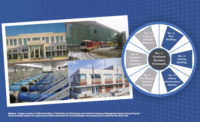The schools performed so well because they are built or retrofitted according to much stricter seismic codes than commercial and residential buildings.
"There was no structural damage to any school in the district, even the ones built to older codes in the 1940s, 1950s and 1960s," says Quattrocchi. "Part of this is because seismic upgrades at the schools are treated the same as building an entirely new facility," he adds.
Schools fared well for three reasons: seismic building codes that are more stringent than those for commercial buildings, methodical reviews by the Division of the State Architect and "full-time" state inspection on school construction sites, Quattrocchi says.
A 2006 California Seismic Safety Commission report—the most recently published data on unreinforced masonry buildings in the state—says approximately 70% of California's 26,000 brick buildings have been demolished or retrofitted. About 8,000 brick buildings remain at risk, the report said.
In Napa, city inspectors remained at work tagging structures on the second round of damage evaluations. "As of 1 p.m., there are 1,053 structures in the city that have been tagged—153 are on the red-tag list and around 900 are on the yellow-tag list," the City of Napa reports. "It is possible these numbers will rise as more structures receive their second inspection and interiors are seen."
Ronald O. Hamburger, a senior principal with seismic structural engineer Simpson Gumpertz & Heger, says buildings in general fared well. "Overall, the performance of buildings in the Bay Area is a tribute to the effectiveness of building codes in general and seismic retrofit techniques," he says. Except for unreinforced or poorly retrofitted masonry buildings and older houses not bolted to their foundations, "buildings did very well, despite ground accelerations, locally in Napa, that approached design levels. In part this was due to the relatively short duration (10 seconds of strong motion) of this earthquake, but also, at least in part, it is a tribute to the effectiveness of western U.S. design practices."
Sept. 8, 2014 This file has been updated. An earlier version incorrectly identifed the firm Quattrocchi Kwok Architects. A quote from Mark Quattrocchi, principal and member of a post-quake survey team, implied that there was no cracked drywall in any school within the Napa District's 30 campuses. He was describing only a single school that was recently constructed.




Post a comment to this article
Report Abusive Comment